Machine Learning for Fire Safety in the Built Environment: A Bibliometric Insight into Research Trends and Key Methods
Abstract
1. Introduction
- Which countries, authors, journals, and publications have primarily integrated machine learning into fire safety problems?
- In which thematic categories is machine learning applied within fire safety?
- What are the most frequently used machine learning algorithms, and what are the reasons behind these preferences?
2. Methodology
3. Bibliometric Analysis Results
3.1. Most Relevant Sources
3.2. Most Frequent Author Keywords
3.3. Most Relevant Authors
3.4. Country Collaborations
3.5. Most Relevant Studies
4. Discussion and Conclusions
Funding
Data Availability Statement
Conflicts of Interest
References
- Budny, I.; Giuliani, L. A comparison between prescriptive- and performance-based approaches in fire safety design of structures. In Proceedings of the 2nd Conference on Handling Exceptions in Structural Engineering: Structural Systems, Accidental Scenarios, Design Complexity, Rome, Italy, 8–9 July 2010; Available online: https://www.academia.edu/48104129/A_comparison_between_prescriptive_and_performance_based_approaches_in_fire_safety_design_of_structures (accessed on 20 June 2025).
- Su, L.-C.; Wu, X.; Zhang, X.; Huang, X. Smart Performance-Based Design for Building Fire Safety: Prediction of Smoke Motion via AI. J. Build. Eng. 2021, 43, 102529. [Google Scholar] [CrossRef]
- Alvarez, A.; Meacham, B.; Dembsey, N.; Thomas, J. Twenty years of performance-based fire protection design: Challenges faced and a look ahead. J. Fire Prot. Eng. 2013, 23, 249–276. [Google Scholar] [CrossRef]
- Bénichou, N.; Kashef, A. How to Use Fire Risk Assessment Tools to Evaluate Performance-Based Designs. In Proceedings of the CIB 2004, World Building Congress, Toronto, ON, Canada, 2–7 May 2004; pp. 1–11. Available online: https://publications-cnrc.canada.ca/fra/voir/objet/?id=d00d99ce-067e-454b-bf8f-f64375bd39b3 (accessed on 20 June 2025).
- Yıldız, M.A.; Beyhan, F. Evaluation of Vertical Interior Voids in Green Building Designs in the Context of Smoke Extraction. J. Fac. Eng. Archit. Gazi Univ. 2024, 39, 1485–1498. [Google Scholar] [CrossRef]
- Yıldız, M.A.; Yıldız, M.E. Numerical Analysis of the Effect of Double Skin Façade Types on Fire Behaviour. Građevinar 2024, 76, 1017–1028. [Google Scholar] [CrossRef]
- Shafighfard, T.; Bagherzadeh, F.; Abdollahi Rizi, R.; Yoo, D.-Y. Data-Driven Compressive Strength Prediction of Steel Fiber Reinforced Concrete (SFRC) Subjected to Elevated Temperatures Using Stacked Machine Learning Algorithms. J. Mater. Res. Technol. 2022, 21, 3777–3794. [Google Scholar] [CrossRef]
- Kazemi, F.; Shafighfard, T.; Yoo, D.-Y. Data-Driven Modeling of Mechanical Properties of Fiber-Reinforced Concrete: A Critical Review. Arch. Comput. Methods Eng. 2024, 31, 2049–2078. [Google Scholar] [CrossRef]
- Ertosun Yıldız, M.; Beyhan, F. Prediction of Cooling Load via Machine Learning on Building Envelope Design Parameters. J. Build. Eng. 2025, 100, 111724. [Google Scholar] [CrossRef]
- Zhang, T.; Wang, Z.; Zeng, Y.; Wu, X.; Huang, X.; Xiao, F. Building Artificial-Intelligence Digital Fire (AID-Fire) system: A real-scale demonstration. J. Build. Eng. 2022, 62, 105363. [Google Scholar] [CrossRef]
- Parekh, R.; Smith, C. Innovative AI-Driven Software for Fire Safety Design: Implementation in Vast Open Structure. World J. Adv. Eng. Technol. Sci. 2024, 12, 741–750. [Google Scholar] [CrossRef]
- Parekh, R. Applications of Artificial Intelligence in Enhancing Building Fire Safety. Int. J. Sci. Res. Arch. 2024, 13, 1117–1132. [Google Scholar] [CrossRef]
- Zeng, Y.; Zhang, X.; Su, L.-C.; Wu, X.; Huang, X. Artificial Intelligence Tool for Fire Safety Design (IFETool): Demonstration in Large Open Spaces. Case Stud. Therm. Eng. 2022, 40, 102483. [Google Scholar] [CrossRef]
- Johnson, P.F. International implications of performance-based fire engineering design codes. J. Fire Prot. Eng. 1993, 5, 141–146. [Google Scholar] [CrossRef]
- Buchanan, A.H. Fire engineering for a performance based code. Fire Saf. J. 1994, 23, 1–16. [Google Scholar] [CrossRef]
- Ministry of Business, Innovation & Employment (MBIE). New Zealand Building Code Clauses C1–C6: Protection from Fire; MBIE: Wellington, New Zealand, 2014; Available online: https://cdn.abcs.co.nz/resources/Building%20Code%20Compliance%20Documents/2014/C%20Clauses/c-vm2-protection-from-fire-commentary.pdf (accessed on 2 April 2025).
- UK-Building Regulations. Approved Document B: Fire Safety; HMSO: London, UK, 1991. [Google Scholar]
- UK-Building Regulations. Approved Document B (Fire Safety); HMSO: London, UK, 2006. [Google Scholar]
- Society of Fire Protection Engineers (SFPE). Engineering Guide to Performance-Based Fire Protection Analysis and Design of Buildings; Society of Fire Protection Engineers (SFPE): Bethesda, MD, USA, 1996. [Google Scholar]
- National Fire Protection Association (NFPA). NFPA 5000: Building Construction and Safety Code; NFPA: Quincy, MA, USA, 2001. [Google Scholar]
- National Fire Protection Association (NFPA). NFPA 101: Life Safety Code—Performance-Based Option; NFPA: Quincy, MA, USA, 2003. [Google Scholar]
- Japan Building Research Institute (JBRI). Fire Safety Engineering Guidelines for Buildings in Japan; JBRI: Tokyo, Japan, 2000. [Google Scholar]
- Kohno, M.; Okazaki, T. Performance-Based Fire Safety Design in Japan: Challenges and Progress. Int. J. High-Rise Build. 2013, 2, 22–30. [Google Scholar]
- Hosser, D.; Dorn, T.; El-Nesr, O. Experimental and numerical studies of composite beams exposed to fire. J. Struct. Eng. 1994, 120, 2871–2891. [Google Scholar] [CrossRef]
- Koya, K.; Ohmiya, Y.; Harada, K.; Tanaka, T.; Hokugo, A.; Hagiwara, I. A pilot case study of a performance-based fire safety design method to a multi-tenant office building. AIJ J. Technol. Des. 1997, 3, 138–141. [Google Scholar] [CrossRef]
- Xie, H.; Zhang, Y.; Wu, Z.; Lv, T. A bibliometric analysis on land degradation: Current status, development, and future directions. Land 2020, 9, 28. [Google Scholar] [CrossRef]
- Lee, I.S.; Lee, H.; Chen, Y.H.; Chae, Y. Bibliometric analysis of research assessing the use of acupuncture for pain treatment over the past 20 years. J. Pain. Res. 2020, 11, 367–376. [Google Scholar] [CrossRef]
- Wang, X.; Lu, J.; Song, Z.; Zhou, Y.; Liu, T.; Zhang, D. From past to future: Bibliometric analysis of global research productivity on nomogram (2000–2021). Front. Public Health 2020, 10, 997713. [Google Scholar] [CrossRef]
- Randolph, J.J.; Julnes, G.; Bednarik, R.; Sutinen, E. A comparison of the methodological quality of articles in computer science education journals and conference proceedings. Comput. Sci. Educ. 2007, 17, 263–274. [Google Scholar] [CrossRef]
- Rahm, E. Comparing the scientific impact of conference and journal publications in computer science. Inf. Serv. Use 2007, 28, 127–128. [Google Scholar] [CrossRef]
- Kalantari, A.; Kamsin, A.; Kamaruddin, H.; Ale Ebrahim, N.; Gani, A.; Ebrahimi, A.; Shamshirband, S. A bibliometric approach to tracking big data research trends. J. Big Data 2017, 4, 30. [Google Scholar] [CrossRef]
- Van Eck, N.; Waltman, L. Software survey: VOSviewer, a computer program for bibliometric mapping. Scientometrics 2010, 84, 523–538. [Google Scholar] [CrossRef] [PubMed]
- Chen, X.; Zou, D.; Kohnke, L.; Xie, H.; Cheng, G. Affective states in digital game-based learning: Thematic evolution and social network analysis. PLoS ONE 2021, 16, e0255184. [Google Scholar] [CrossRef]
- Nikolentzos, G.; Panagopoulos, G.; Evdaimon, I.; Vazirgiannis, M. Can Author Collaboration Reveal Impact? The Case of H-Index. In Predicting the Dynamics of Research Impact; Manolopoulos, Y., Vergoulis, T., Eds.; Springer: Cham, Switzerland, 2021. [Google Scholar] [CrossRef]
- Bihari, A.; Tripathi, S. Key author analysis in research professionals’ relationship network using citation indices and centrality. Procedia Comput. Sci. 2015, 57, 606–613. [Google Scholar] [CrossRef]
- Bibi, F.; Khan, H.; Iqbal, T.; Farooq, M.; Mehmood, I.; Nam, Y. Ranking authors in an academic network using social network measures. Appl. Sci. 2018, 8, 1824–1842. [Google Scholar] [CrossRef]
- Bornmann, L.; Marx, W.; Barth, A. The normalization of citation counts based on classification systems. J. Informetr. 2013, 7, 158–165. [Google Scholar] [CrossRef]
- Waltman, L.; van Eck, N.J. Field-normalized citation impact indicators and the choice of an appropriate counting method. J. Informetr. 2015, 9, 872–894. [Google Scholar] [CrossRef]
- Zhang, X.; Ding, Y.; Wang, J.; Zhu, J. Exploring the role of international research collaboration in building China’s World-Class Universities. Sustainability 2022, 14, 3487. [Google Scholar] [CrossRef]
- Kwiek, M. International Research Collaboration and International Research Orientation: Comparative Findings About European Academics. J. Stud. Int. Educ. 2018, 22, 136–160. [Google Scholar] [CrossRef]
- Frizzi, S.; Kaabi, R.; Bouchouicha, M.; Ginoux, J.M.; Moreau, E.; Fnaiech, F. Convolutional neural network for video fire and smoke detection. In Proceedings of the IECON 2016—42nd Annual Conference of the IEEE Industrial Electronics Society, Florence, Italy, 22 December 2016; pp. 877–882. [Google Scholar] [CrossRef]
- Kyrkou, C.; Theocharides, T. EmergencyNet: Efficient aerial image classification for drone-based emergency monitoring using atrous convolutional feature fusion. IEEE J. Sel. Top. Appl. Earth Obs. Remote Sens. 2020, 13, 1687–1699. [Google Scholar] [CrossRef]
- Valikhujaev, Y.; Abdusalomov, A.; Cho, Y.I. Automatic fire and smoke detection method for surveillance systems based on dilated CNNs. Atmosphere 2020, 11, 1241. [Google Scholar] [CrossRef]
- Li, Y.; Zhang, W.; Liu, Y.; Jing, R.; Liu, C. An efficient fire and smoke detection algorithm based on an end-to-end structured network. Eng. Appl. Artif. Intell. 2022, 116, 105492. [Google Scholar] [CrossRef]
- Dung, N.M.; Kim, D.; Ro, S. A video smoke detection algorithm based on cascade classification and deep learning. KSII Trans. Internet Inf. Syst. 2018, 12, 6018–6033. [Google Scholar] [CrossRef]
- Li, Y.; Zhang, W.; Liu, Y. A visualized fire detection method based on convolutional neural network beyond anchor. Appl. Intell. 2022, 52, 13280–13295. [Google Scholar] [CrossRef]
- Ren, X.; Li, C.; Ma, X.; Chen, F.; Wang, H.; Sharma, A.; Gaba, G.S.; Masud, M. Design of Multi-Information Fusion Based Intelligent Electrical Fire Detection System for Green Buildings. Sustainability 2021, 13, 3405. [Google Scholar] [CrossRef]
- Abdusalomov, A.; Baratov, N.; Kutlimuratov, A.; Whangbo, T.K. An improvement of the fire detection and classification method using YOLOv3 for surveillance systems. Sensors 2021, 21, 6519. [Google Scholar] [CrossRef]
- Ahn, Y.; Choi, H.; Kim, B.S. Development of early fire detection model for buildings using computer vision-based CCTV. J. Build. Eng. 2023, 65, 105647. [Google Scholar] [CrossRef]
- Wang, J.; Zhang, X.; Jing, K.; Zhang, C. Learning precise feature via self-attention and self-cooperation YOLOX for smoke detection. Expert Syst. Appl. 2023, 228, 120330. [Google Scholar] [CrossRef]
- Andrew, A.M.; Zakaria, A.; Saad, S.M.; Shakaff, A.Y.M. Multi-stage feature selection based intelligent classifier for classification of incipient stage fire in building. Sensors 2016, 16, 31. [Google Scholar] [CrossRef]
- Lo, S.M.; Liu, M.; Zhang, P.H.; Yuen, K.K. An artificial neural-network based predictive model for pre-evacuation human response in domestic building fire. Fire Technol. 2009, 45, 431–449. [Google Scholar] [CrossRef]
- Chen, Y.; Hu, S.; Mao, H.; Deng, W.; Gao, X. Application of the best evacuation model of deep learning in the design of public structures. Image Vis. Comput. 2020, 102, 103975. [Google Scholar] [CrossRef]
- Yang, P.; Sun-Wei, L.; Zhen-Zhong, H. A self-learning dynamic path planning method for evacuation in large public buildings based on neural networks. Neurocomputing 2019, 365, 71–85. [Google Scholar] [CrossRef]
- Gu, J.; Wang, J.; Guo, X.; Liu, G.; Qin, S.; Bi, Z. A metaverse-based teaching building evacuation training system with deep reinforcement learning. IEEE Trans. Syst. Man Cybern. Syst. 2022, 53, 2209–2219. [Google Scholar] [CrossRef]
- Li, Z.; Xu, W. Pedestrian evacuation within limited-space buildings based on different exit design schemes. Saf. Sci. 2019, 124, 104575. [Google Scholar] [CrossRef]
- Buettner, R.; Baumgartl, H. A highly effective deep learning based escape route recognition module for autonomous robots in crisis and emergency situations. In Proceedings of the 52nd Annual Hawaii International Conference on System Sciences, Maui, HI, USA, 8–11 January 2019; pp. 659–666. Available online: https://hdl.handle.net/10125/59506 (accessed on 20 June 2025).
- Wang, K.; Shi, X.P.; Goh, A.P.X.; Qian, S.Z. A machine learning-based study on pedestrian movement dynamics under emergency evacuation. Fire Saf. J. 2019, 106, 163–176. [Google Scholar] [CrossRef]
- Zhu, R.; Becerik-Gerber, B.; Lin, J.; Li, N. Behavioral, data-driven, agent-based evacuation simulation for building safety design using machine learning and discrete choice models. Adv. Eng. Inform. 2023, 55, 101827. [Google Scholar] [CrossRef]
- Ding, Y.; Zhang, Y.; Huang, X. Intelligent emergency digital twin system for monitoring building fire evacuation. J. Build. Eng. 2023, 77, 107416. [Google Scholar] [CrossRef]
- Deng, H.; Ou, Z.; Zhang, G.; Deng, Y.; Tian, M. BIM and computer vision-based framework for fire emergency evacuation considering local safety performance. Sensors 2021, 21, 3851. [Google Scholar] [CrossRef]
- Atila, U.; Ortakci, Y.; Ozacar, K.; Demiral, E.; Karas, I.R. SmartEscape: A mobile smart individual fire evacuation system based on 3D spatial model. ISPRS Int. J. Geo Inf. 2018, 7, 223. [Google Scholar] [CrossRef]
- Yoo, S.-J.; Choi, S.-H. Indoor AR Navigation and Emergency Evacuation System Based on Machine Learning and IoT Technologies. IEEE Internet Things J. 2022, 9, 20853–20868. [Google Scholar] [CrossRef]
- Cheng, J.C.P.; Chen, K.; Wong, P.K.Y.; Chen, W.; Li, C.T. Graph-based network generation and CCTV processing techniques for fire evacuation. Build. Res. Inf. 2020, 49, 179–196. [Google Scholar] [CrossRef]
- Fu, F. Fire induced progressive collapse potential assessment of steel framed buildings using machine learning. J. Constr. Steel Res. 2020, 166, 105918. [Google Scholar] [CrossRef]
- Wang, Z.; Zhang, T.; Wu, X.; Huang, X. Predicting transient building fire based on external smoke images and deep learning. J. Build. Eng. 2022, 47, 103823. [Google Scholar] [CrossRef]
- Mozaffari, M.H.; Li, Y.; Ko, Y. Real-time detection and forecast of flashovers by the visual room fire features using deep convolutional neural networks. J. Build. Eng. 2023, 64, 105674. [Google Scholar] [CrossRef]
- Kou, L.; Wang, X.; Guo, X.; Zhu, J.; Zhang, H. Deep learning-based inverse model for building fire source location and intensity estimation. Fire Saf. J. 2021, 121, 103310. [Google Scholar] [CrossRef]
- Buffington, T.; Cabrera, J.M.; Kurzawski, A. Deep-learning emulators of transient compartment fire simulations for inverse problems and room-scale calorimetry. Fire Technol. 2021, 57, 2859–2885. [Google Scholar] [CrossRef]
- Liu, G.; Meng, H.; Qu, G.; Wang, L.; Ren, L.; Lu, H. Real-time monitoring and prediction method of commercial building fire temperature field based on distributed optical fiber sensor temperature measurement system. J. Build. Eng. 2023, 70, 106403. [Google Scholar] [CrossRef]
- Rahmati, M.; Toufigh, V. Evaluation of geopolymer concrete at high temperatures: An experimental study using machine learning. J. Clean. Prod. 2022, 372, 133608. [Google Scholar] [CrossRef]
- Li, A.; Yuen, A.C.Y.; Wang, W.; Weng, J.; Yeoh, G.H. Numerical investigation on the thermal management of lithium-ion battery system and cooling effect optimization. Appl. Therm. Eng. 2022, 215, 118966. [Google Scholar] [CrossRef]
- Dash, P.K.; Parhi, S.K.; Patro, S.K.; Panigrahi, R. Efficient machine learning algorithm with enhanced cat swarm optimization for prediction of compressive strength of GGBS-based geopolymer concrete at elevated temperature. Constr. Build. Mater. 2023, 400, 132814. [Google Scholar] [CrossRef]
- Yuen, A.C.Y.; Chen, T.B.Y.; De Cachinho Cordero, I.M.; Liu, H.; Li, A.; Yang, W.; Cheung, S.C.P.; Chan, Q.N.; Kook, S.; Yeoh, G.H. Developing a solid decomposition kinetics extraction framework for detailed chemistry pyrolysis and combustion modelling of building polymer composites. J. Anal. Appl. Pyrolysis 2022, 163, 105500. [Google Scholar] [CrossRef]
- Pan, Y.; Braun, A.; Brilakis, I.; Borrmann, A. Enriching geometric digital twins of buildings with small objects by fusing laser scanning and AI-based image recognition. Autom. Constr. 2022, 140, 104375. [Google Scholar] [CrossRef]
- Vandecasteele, F.; Merci, B.; Verstockt, S. Fireground location understanding by semantic linking of visual objects and building information models. Fire Saf. J. 2017, 91, 1026–1034. [Google Scholar] [CrossRef]
- Chokwitthaya, C.; Zhu, Y.; Mukhopadhyay, S.; Collier, E. Augmenting building performance predictions during design using generative adversarial networks and immersive virtual environments. Autom. Constr. 2020, 119, 103350. [Google Scholar] [CrossRef]
- Chokwitthaya, C.; Zhu, Y.; Dibiano, R.; Mukhopadhyay, S. Combining context-aware design-specific data and building performance models to improve building performance predictions during design. Autom. Constr. 2019, 107, 102917. [Google Scholar] [CrossRef]
- Ouache, R.; Nahiduzzaman, K.M.; Hewage, K.; Sadiq, R. Performance investigation of fire protection and intervention strategies: Artificial neural network-based assessment framework. J. Build. Eng. 2021, 42, 102439. [Google Scholar] [CrossRef]
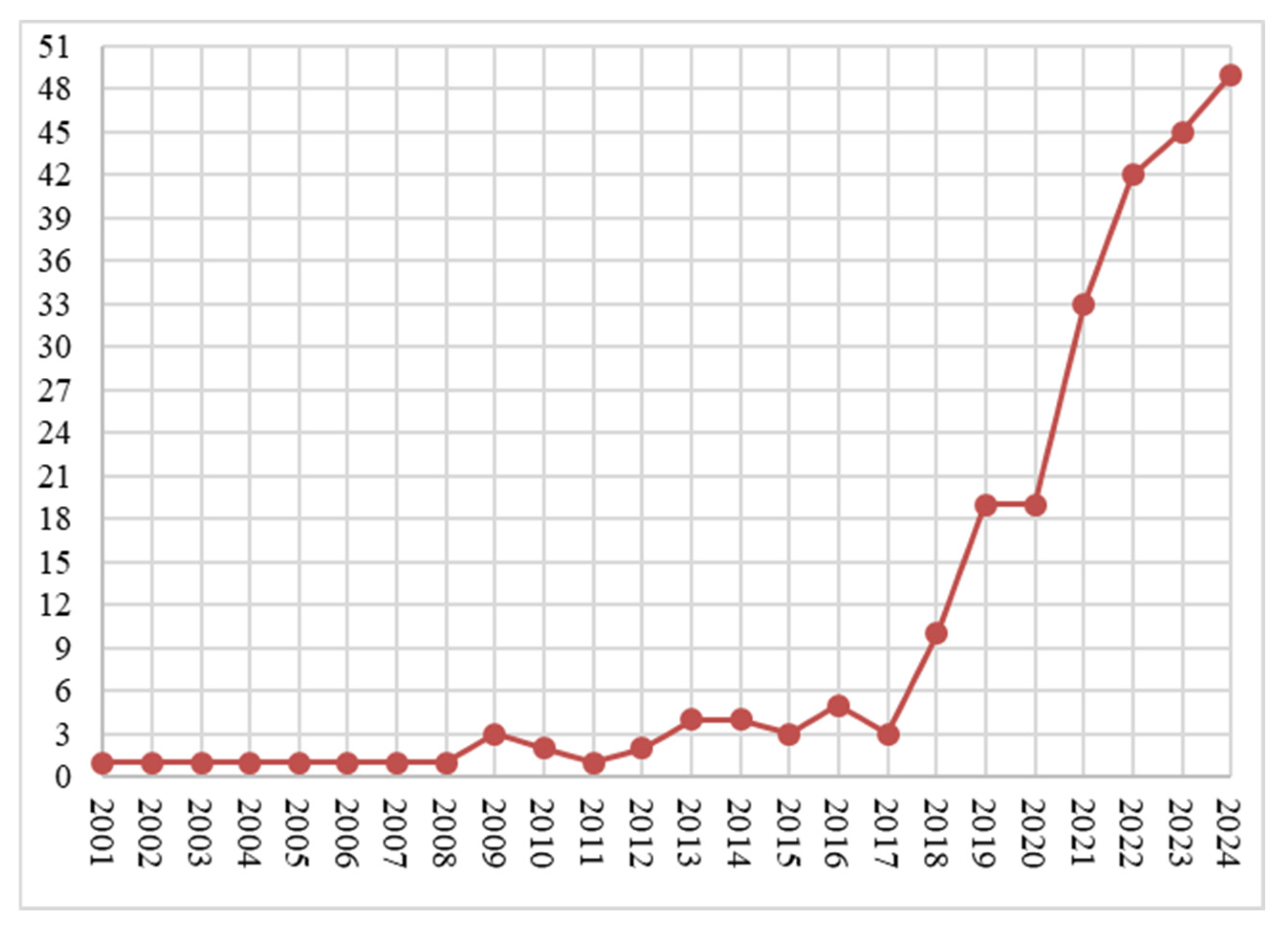
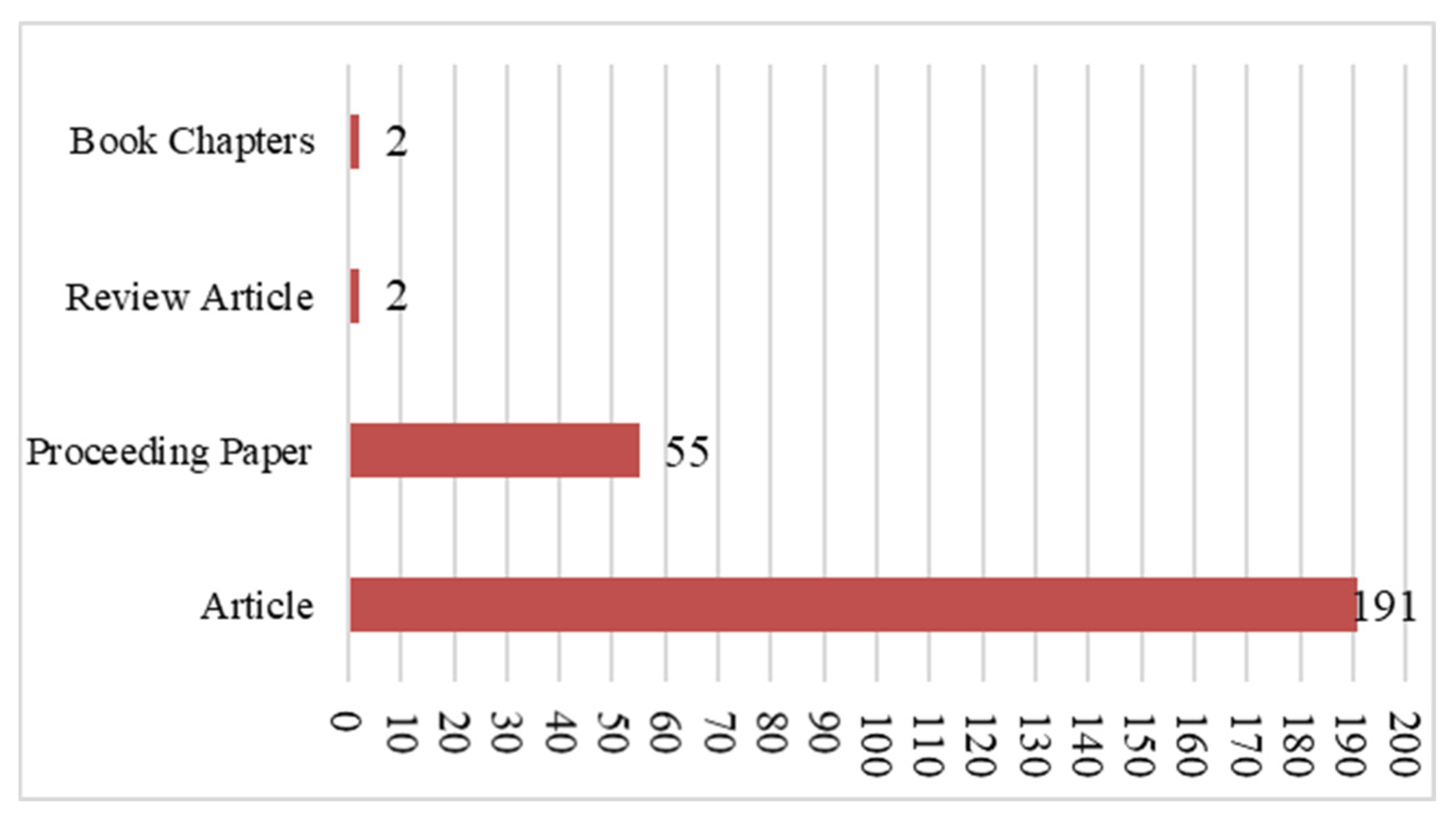
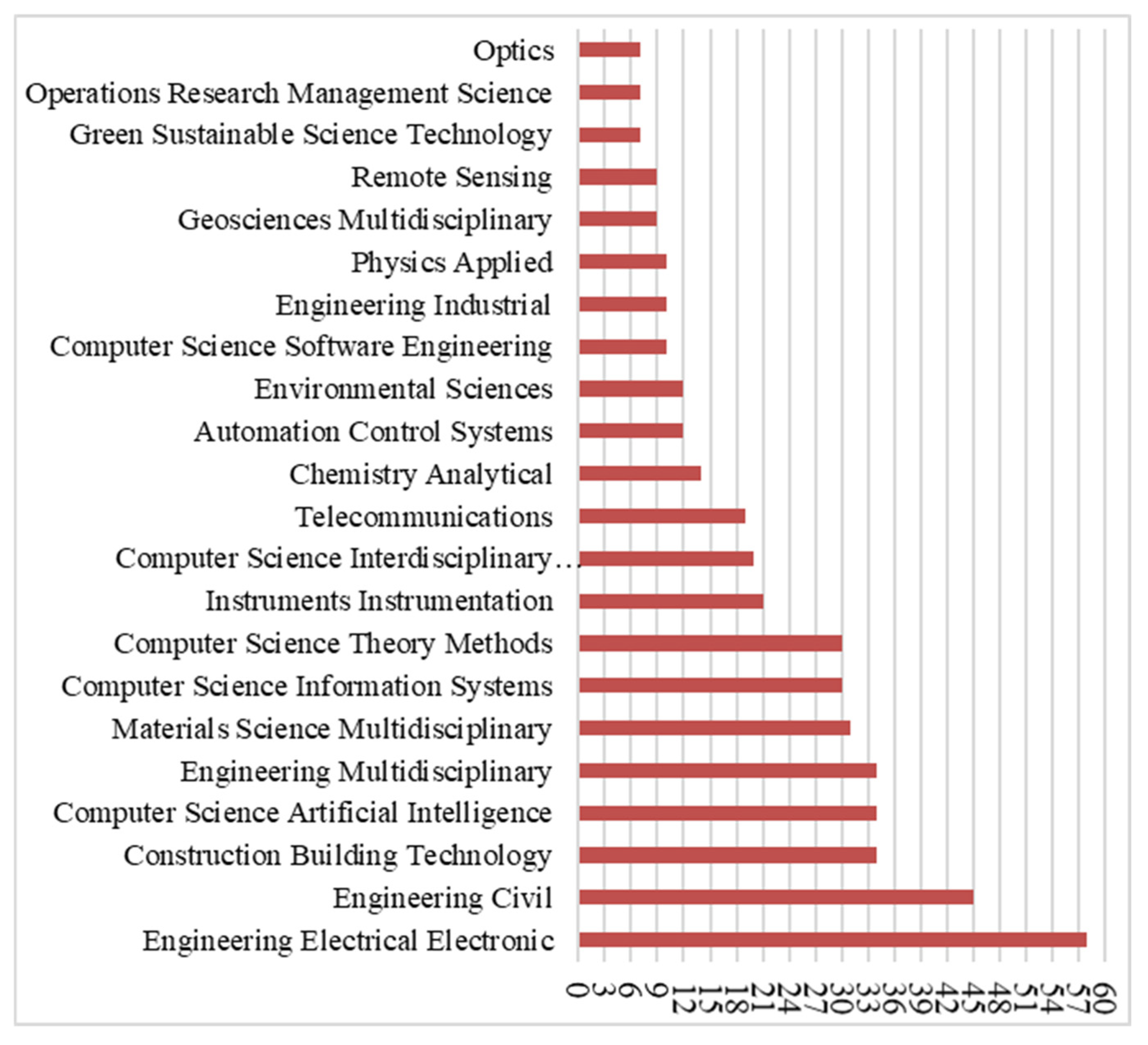
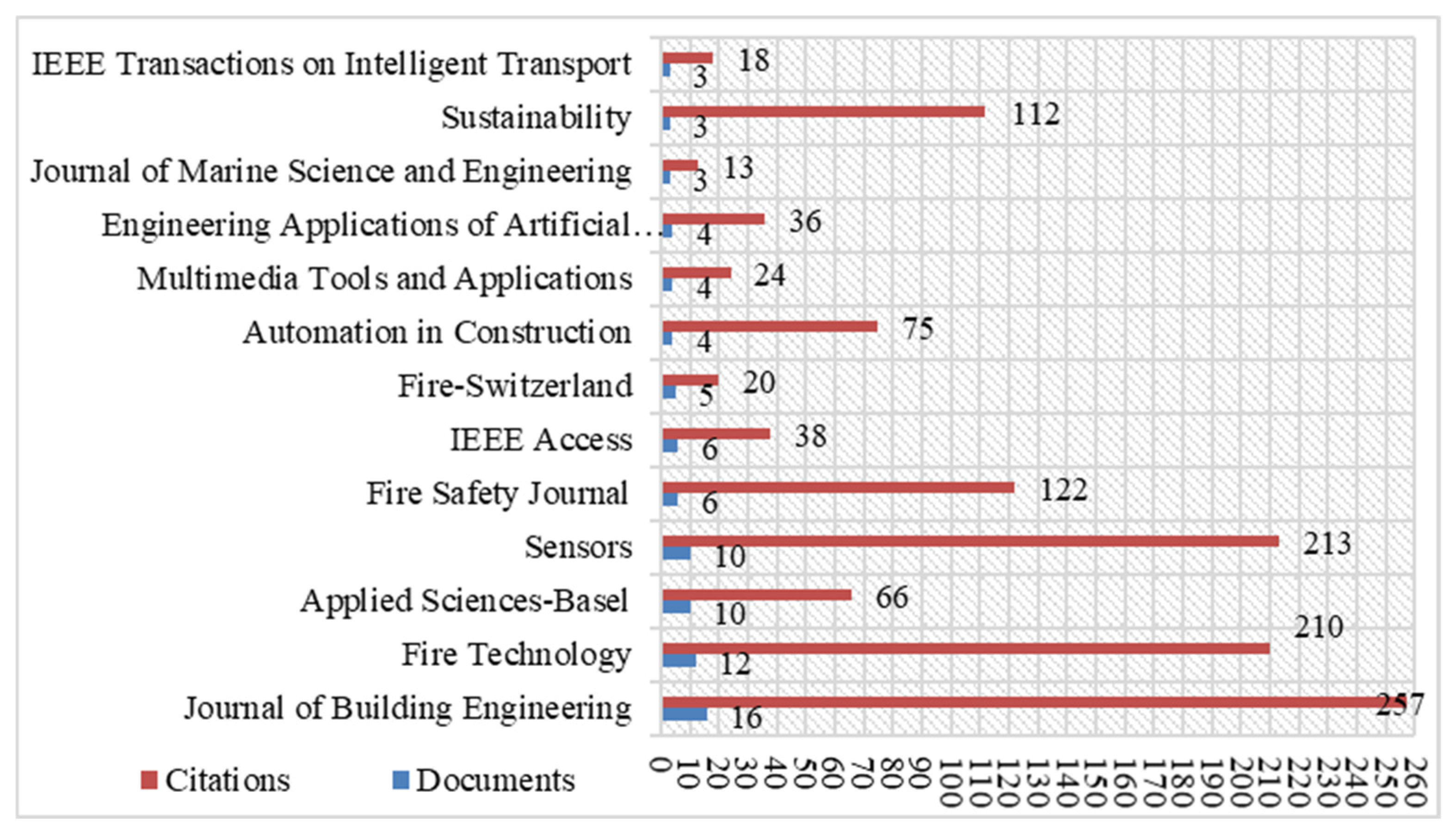
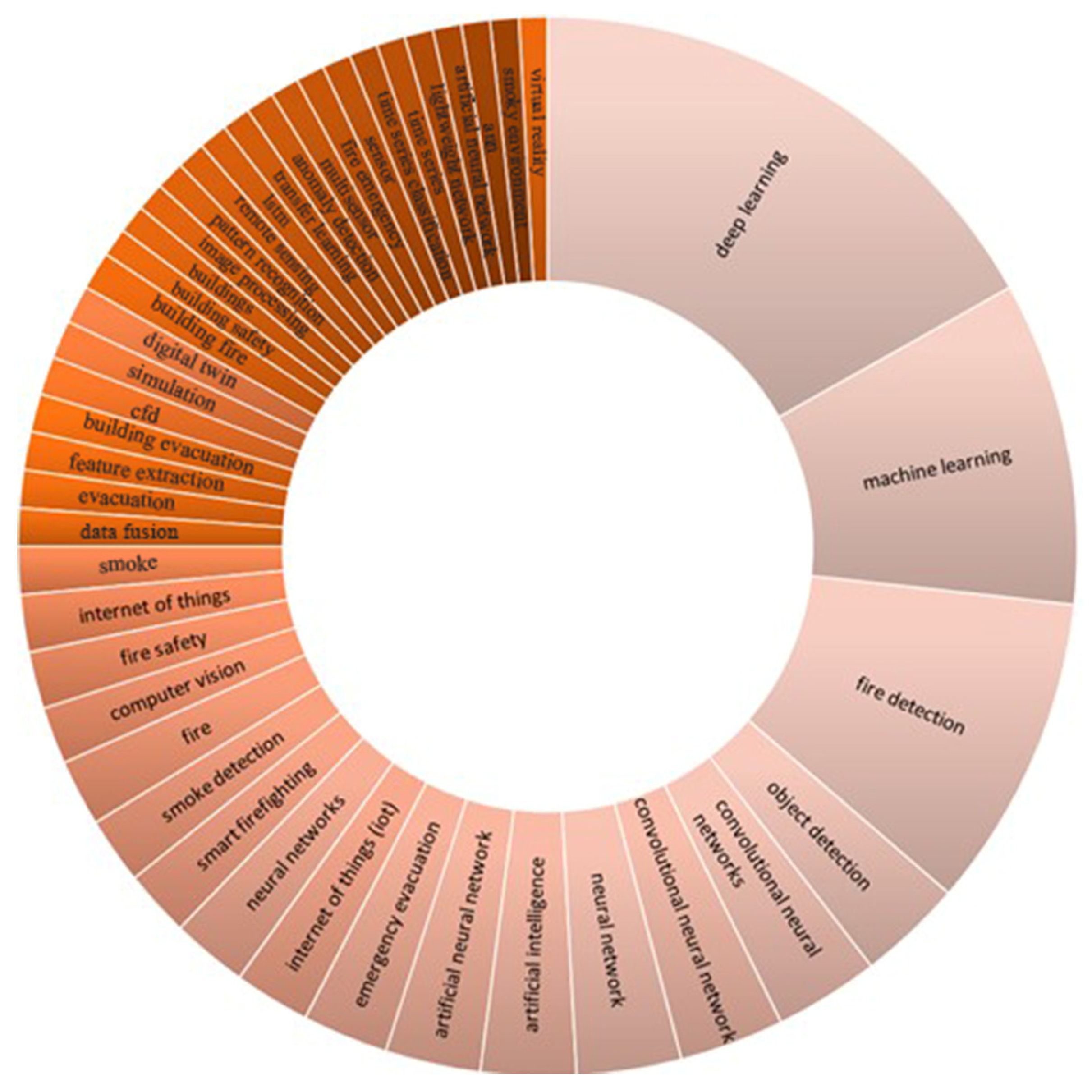
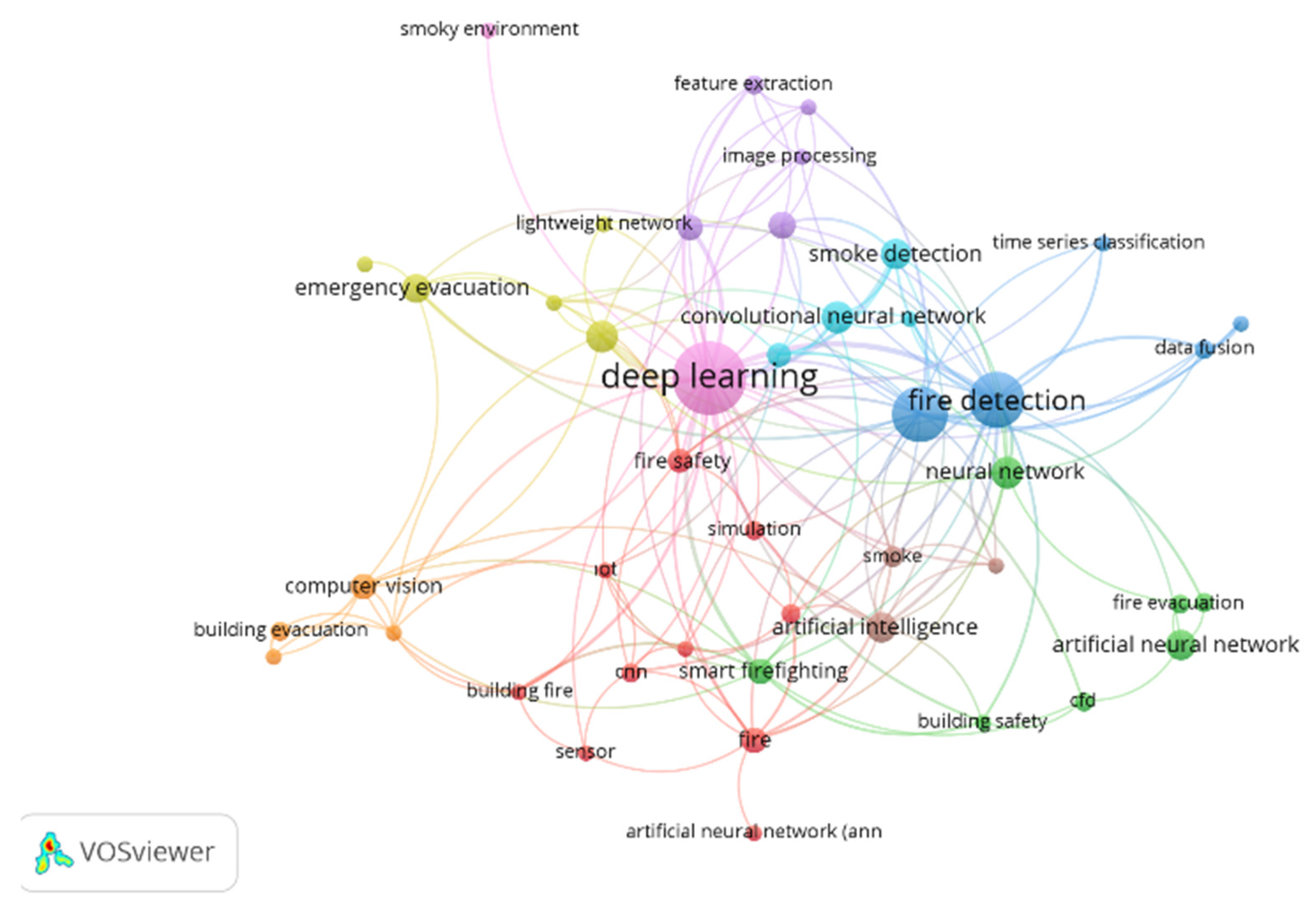


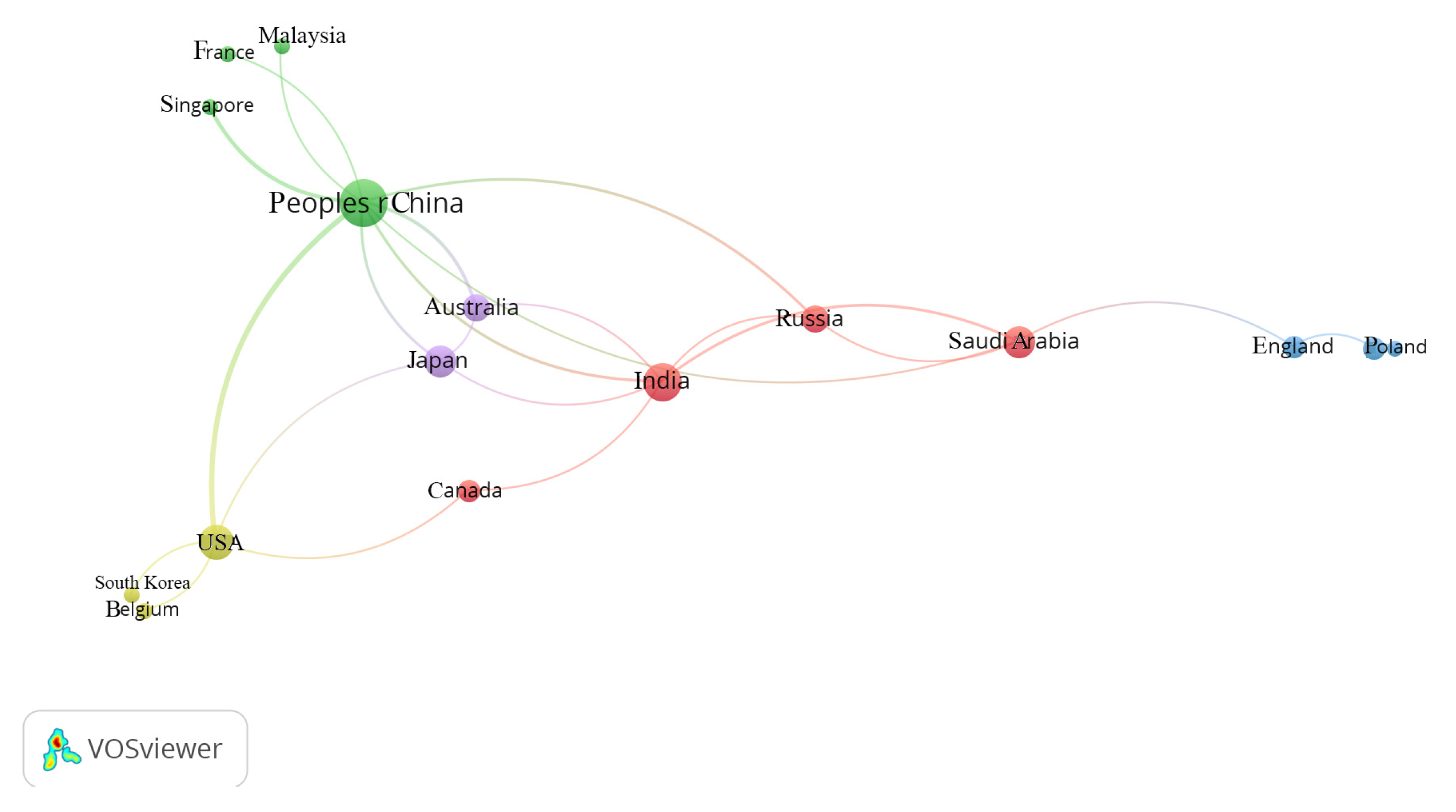
| Features | PA | PB | AI |
|---|---|---|---|
| Flexibility | Low | Medium | High |
| Time | Low | High | Very low |
| Simulation | - | Existent | Existent |
| Real Time Data | - | Local | Existent |
| Preventive Measures | - | Medium | High |
| Predictive Safety | - | Medium | High |
| Sensing and Monitoring | - | - | High |
| Human Behavior | - | Existent | Existent |
| Topic | “fire” or “smoke” or “fire detection” or “evacuation “ | |
| And | Topic | “built environment” or “building” or “civil structure” |
| And | Topic | “machine learning” or “deep learning” or “neural network” or “predictive modeling” or “decision tree” or “vector machine” |
| Not | Topic | “forest” or “wildfire” or “medical” or “car” or “road” |
| Authors | Article | Citation | Normalized Citation | Average Year |
|---|---|---|---|---|
| Wu, X | 4 | 130 | 9.72 | 2021.75 |
| Wang, Z | 3 | 83 | 8.2 | 2022.67 |
| Abdusalomov, A | 2 | 119 | 5.81 | 2020.5 |
| Hu, Z | 2 | 72 | 4.77 | 2020 |
| Li, A | 2 | 55 | 4.54 | 2022 |
| Yeoh, G H | 3 | 55 | 4.54 | 2017.67 |
| Yuen, A C Y | 2 | 55 | 4.54 | 2022 |
| Liu, G | 2 | 18 | 4.42 | 2023.5 |
| Qu, G | 2 | 18 | 4.42 | 2023.5 |
| Ren, L | 2 | 18 | 4.42 | 2023.5 |
| Wang, L | 2 | 18 | 4.42 | 2023.5 |
| Li, Y | 3 | 49 | 4.05 | 2022 |
| Liu, Y | 3 | 49 | 4.05 | 2022 |
| Zhang, W | 3 | 49 | 4.05 | 2022 |
| Xiao, F | 2 | 32 | 3.99 | 2023 |
| Zeng, Y | 3 | 37 | 3.73 | 2022.67 |
| Huang, D | 2 | 46 | 3.12 | 2019 |
| Shibasaki, R | 2 | 46 | 3.12 | 2019 |
| Song, X | 2 | 46 | 3.12 | 2019 |
| Kumar, A | 2 | 56 | 3.09 | 2020.5 |
| Singh, A | 2 | 56 | 3.09 | 2020.5 |
| Su, L | 2 | 49 | 3.03 | 2021.5 |
| Zhang, X | 2 | 49 | 3.03 | 2021.5 |
| Buffington, T | 3 | 41 | 2.41 | 2021 |
| Liu, J | 2 | 20 | 2.26 | 2022.5 |
| Chokwitthaya, C | 2 | 41 | 2.1 | 2019.5 |
| Mukhopadhyay, S | 2 | 41 | 2.1 | 2019.5 |
| Zhu, Y | 2 | 41 | 2.1 | 2019.5 |
| Hu, Y | 2 | 20 | 2.08 | 2022.5 |
| Li, J | 2 | 20 | 2.08 | 2022.5 |
| Ezekoye, O A | 2 | 34 | 2 | 2021 |
| Gottuk, D | 2 | 46 | 2 | 2022 |
| Hammond, M | 2 | 46 | 2 | 2022 |
| Hart, S | 2 | 46 | 2 | 2022 |
| Rose-pehrsson, S | 2 | 46 | 2 | 2022 |
| Wong, J | 2 | 46 | 2 | 2022 |
| Wright, M | 2 | 46 | 2 | 2022 |
| Merci, B | 2 | 18 | 1.8 | 2020.5 |
| Verstockt, S | 2 | 18 | 1.8 | 2020.5 |
| Huang, X | 7 | 160 | 1.62 | 2022.71 |
| Bilyaz, S | 2 | 18 | 1.06 | 2021 |
| Zhang, T | 5 | 93 | 1.02 | 2023 |
| Model | Unstandardized Coefficients | Standardized Coefficients | t | Sig. (p) | |
|---|---|---|---|---|---|
| B | Std. Error | Beta (ß) | |||
| (Constant) | −215.809 | 66.308 | −3.255 | 0.002 | |
| Article | −1.054 | 0.348 | −0.583 | −3.026 | 0.004 |
| Citiation | 0.045 | 0.011 | 0.789 | 4.193 | 0.000 |
| AvYear | 0.109 | 0.033 | 0.437 | 3.302 | 0.002 |
| Category | Machine Learning Subcategory | Scientific Field |
|---|---|---|
| Fire Detection and Early Warning Systems | Convolutional Neural Network (CNN) [2,41,42,43,44,45,46]. Fuzzy Logic Reasoning [47]. Neural Network [47]. CNN based on YOLOv3 (You Only Look Once) [48]. Deep Learning [49]. Detection Transformer (DETR) [44]. YOLOX [50]. Probabilistic Neural Network (PNN) [51]. Lightweight CNN [46]. | Fire detection by classifying objects and extracting features from image data [41]. Detection of common arc faults in low voltage systems for early detection of electrical fires [47]. Detection of collapsed or burned buildings in difficult disaster areas with UAVs [42]. System that detects fires of different sizes and shapes with high accuracy [48]. A deep learning-based model using dilated convolutions for camera-based fire and smoke detection [43]. A data-driven system that detects construction fires on construction sites [2]. Predictive model for early fire detection in indoor areas, providing faster detection than traditional fire detectors [49]. A faster and more accurate detection mechanism with CNN and DETR model for smoke detection [44]. A system that analyzes the variable structure of smoke and performs precise feature extraction with self-attention and self-cooperation mechanisms to improve smoke detection [50]. Early fire detection system with a CNN based cascade classification model using video surveillance systems and image processing technologies [45]. A low-cost classification model for early fire detection using gas and ambient sensors [51]. A fire detection model suitable for real-time and embedded systems using MobileNetV3 and anchor-free object detection methods [46]. |
| Evacuation and Emergency Management | Recursive Neural Network (RNN) [51]. Convolutional Neural Network (CNN) [46,52] Policy Neural Network [46]. Deep Reinforcement Learning [53]. Cellular Automata Model [54]. Decision Tree [55]. Support Vector Machine (SVM) [55]. Artificial Neural Network (ANN) [55,56,57] Fuzzy Logic [56]. Deep Learning [52,58,59] YOLOv4 Evacuee Detector [58]. Back Propagation Neural Network [60]. Discrete Choice Models [61]. Deep Neural Networks (DNNs) [62]. Q-Learning [62]. | Optimization of evacuation times in metro stations with VR video tracking [53]. Optimizing evacuation processes and rapid escape strategies in large-scale public buildings [54]. Model that provides dynamic guidance for emergency evacuation processes and determines the safest escape routes within the building [55]. Analysis of exit width, door design and crowd movement to optimize evacuation processes [56]. Analysis of pedestrian movement patterns to understand individual movement dynamics during evacuation processes and improve evacuation management [58]. Modeling people’s pre-action responses to evacuation in a fire [52]. Estimating evacuation rates to monitor building fire evacuations and analyze human behavior [60]. A lightweight and high-accuracy convolutional neural network model that optimizes evacuation planning by identifying escape signs, doors, and stairs in emergency scenarios [57]. A framework that automatically determines the safest evacuation route based on the current fire situation to optimize evacuation processes [61]. A mobile-supported smart fire evacuation system that determines the safest and shortest evacuation route by taking into account individual characteristics and dynamic environmental conditions [62]. Analyzing individuals’ navigation preferences to understand and model evacuation behaviors and optimizing evacuation strategies with agent-based simulations [59]. A system that detects emergencies, estimates individual locations, predicts fire spread and offers the safest evacuation route to the user via an IoT-supported network [63]. A real-time fire evacuation system that can adapt to dynamic environmental changes using graph-based networks and IoT sensors [64]. |
| Prediction of Fire Dynamics and Spread | Decision Tree [65]. Neural Network [65]. Monte Carlo Simulation [65]. Convolutional Neural Network (CNN) [66,67]. Gated Recurrent Unit (GRU) [65]. Deep Neural Networks (DNNs) [68]. Artificial Neural Network (ANN) [69]. Deep Learning [67]. Transfer Learning (TL) [70]. Long Short-Term Memory (LSTM) [70]. | Estimating the risk of collapse of steel-framed buildings under fire [65]. A system that predicts smoke spread inside a building in real time [66]. GRU-based deep learning model to predict fire source and intensity inside a building [68]. A model that predicts fire dynamics faster and more efficiently by using ANN and TL to mimic temperature outputs produced by FDS [69]. Detecting signs of flashover and predicting when a fire will reach its flashover point by monitoring its growth through experiments in a real room [67]. Estimation of temperature changes in fire using distributed optical fiber sensors [70]. |
| Fire Load and Material Risk Analysis | Artificial Neural Network (ANN) [71]. Monte Carlo Simülasyonu [71,72]. Extreme Learning Machine (ELM) [73]. Enhanced Cat Swarm Optimization (ECSO) [73]. Genetic Algorithm (GA) [74]. | Building damage assessment by estimating the compressive strength of geopolymer concrete exposed to high temperatures [71]. Thermal management and cooling optimization to reduce thermal runaway and fire risks in lithium-ion battery systems [72]. ELM-ECSO model to predict the compressive strength of geopolymer concrete exposed to high temperatures [73]. A model to predict pyrolysis kinetics to assess fire risks of different insulation materials in buildings [74]. |
| Intelligent Systems and Cyber Security | Deep Learning [75,76]. Convolutional Long-Short Term Memory [10]. Artificial Intelligence Engine [10]. | Creating augmented digital twins that include building fire safety components by combining image recognition and laser scanning techniques [75]. Artificial-Intelligence Digital Fire (AID-Fire) system that integrates digital twin, IoT sensor network and deep learning techniques to provide real-time fire detection and analysis [10]. A semantically linked data management system for the optimal positioning of intervention equipment and escape routes at the fire site [76]. |
| Fire Forecast and Risk Assessment | Artificial Neural Networks (ANNs) [77,78,79]. Generative Adversarial Networks (GANs) [79]. Feature Ranking [78]. | Introducing a new computational framework that improves performance predictions for modeling human-building interactions in building design processes [77,78]. An integrated framework for predicting fire impacts and minimizing fire risk [79]. |
| ML Model | Pros | Cons |
|---|---|---|
| (CNN) | High accuracy in image-based fire and smoke detection | Requires large datasets and long training times |
| (ANN) | Adaptable to various input types; widely used in evacuation prediction | Prone to overfitting without proper regularization |
| (DNN) | Can capture complex nonlinear fire dynamics | Computationally intensive; requires GPU acceleration |
| (DT) | Interpretable structure; quick decision-making | Overfitting likely without pruning; may not generalize well |
| (SVM) | Effective in small-sample fire classification problems | Performance decreases with noisy or high-dimensional data |
| (YOLO) | Real-time detection in visual surveillance systems | Limited to image-based fire applications; needs fine-tuning |
Disclaimer/Publisher’s Note: The statements, opinions and data contained in all publications are solely those of the individual author(s) and contributor(s) and not of MDPI and/or the editor(s). MDPI and/or the editor(s) disclaim responsibility for any injury to people or property resulting from any ideas, methods, instructions or products referred to in the content. |
© 2025 by the author. Licensee MDPI, Basel, Switzerland. This article is an open access article distributed under the terms and conditions of the Creative Commons Attribution (CC BY) license (https://creativecommons.org/licenses/by/4.0/).
Share and Cite
Yıldız, M.A. Machine Learning for Fire Safety in the Built Environment: A Bibliometric Insight into Research Trends and Key Methods. Buildings 2025, 15, 2465. https://doi.org/10.3390/buildings15142465
Yıldız MA. Machine Learning for Fire Safety in the Built Environment: A Bibliometric Insight into Research Trends and Key Methods. Buildings. 2025; 15(14):2465. https://doi.org/10.3390/buildings15142465
Chicago/Turabian StyleYıldız, Mehmet Akif. 2025. "Machine Learning for Fire Safety in the Built Environment: A Bibliometric Insight into Research Trends and Key Methods" Buildings 15, no. 14: 2465. https://doi.org/10.3390/buildings15142465
APA StyleYıldız, M. A. (2025). Machine Learning for Fire Safety in the Built Environment: A Bibliometric Insight into Research Trends and Key Methods. Buildings, 15(14), 2465. https://doi.org/10.3390/buildings15142465






